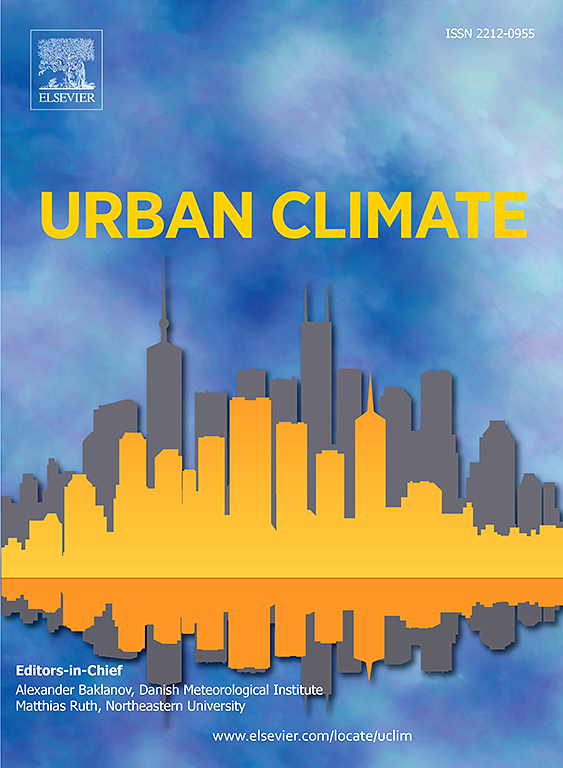评估地表温度地理参数的卫星观测和空间回归
IF 6
2区 工程技术
Q1 ENVIRONMENTAL SCIENCES
引用次数: 0
摘要
城市和工业扩张提高了地表温度(LST),对可持续城市规划提出了挑战。本研究评估了影响阿联酋沙迦大学城地表温度的变量,沙迦大学城是一个经历反向城市热岛效应的半干旱地区。本研究利用气象记录、Landsat 8影像、WorldView-3、航天飞机雷达地形任务(SRTM)和ERA5对土地利用、土地覆盖(LULC)、光谱指数、风速和地形等关键因子进行评估。使用普通最小二乘回归模型评估这些变量之间的关系。研究时间为2020年10月至2021年1月(冬季),2021年6月至2021年8月(夏季)。结果表明,不同因素对地表温度的影响具有季节性。冬季,归一化建筑指数(NDBI)、归一化水指数(NDWI)和风速对地表温度影响显著,R2为0.67。冬季风速与地表温度呈显著正相关,相关系数约为4.95。在夏季,归一化植被指数(NDVI)与风速一起成为关键因子,R2为0.73。风速与地表温度呈负相关,夏季相关系数为- 1.45。开发的LST模型提供了高分辨率的预测LST图,可以填补由于云层覆盖而导致的数据空白。模型偏差包括对住宅区的高估和对道路的低估。这项研究强调了风速的重要性,并通过增加植被来缓解气温上升,从而为城市规划提供了信息。本文章由计算机程序翻译,如有差异,请以英文原文为准。
Satellite observations and spatial regression to assess geographical parameters on land surface temperature
Urban and industrial expansion raises the land surface temperature (LST), posing challenges that require understanding for sustainable city planning. This study assesses variables influencing LST at Sharjah University City, UAE, a semi-arid area experiencing the reverse Urban Heat Island (UHI) effect. This study assess key factors like land use land cover (LULC), spectral indices, wind speed, and topography using meteorological records, Landsat 8 imagery, WorldView-3, Shuttle Radar Topography Mission (SRTM), and ERA5. The relationships among these variables are evaluated using the ordinary least square regression model. The study period spanned from October 2020 to January 2021 (winter) and from June 2021 to August 2021 (summer). The results demonstrate that different factors influence LST seasonally. In winter, the normalized difference built-up index (NDBI), normalized difference water index (NDWI), and wind speed significantly impact LST, with an R2 of 0.67. Wind speed correlates positively with LST during the winter, with a correlation coefficient of approximately 4.95. During the summer, the normalized difference vegetation index (NDVI) emerges as a crucial factor alongside wind speed, resulting in an R2 of 0.73. Conversely, wind speed is negatively correlated with the LST, with a correlation coefficient of −1.45 in the summer. The developed LST model provides high-resolution predicted LST maps that can fill data gaps due to cloud cover. The model discrepancies include overestimation in residential areas and underestimation on roads. This study highlights the importance of wind speed and informs urban planning by adding vegetation that could mitigate temperature rise.
求助全文
通过发布文献求助,成功后即可免费获取论文全文。
去求助
来源期刊

Urban Climate
Social Sciences-Urban Studies
CiteScore
9.70
自引率
9.40%
发文量
286
期刊介绍:
Urban Climate serves the scientific and decision making communities with the publication of research on theory, science and applications relevant to understanding urban climatic conditions and change in relation to their geography and to demographic, socioeconomic, institutional, technological and environmental dynamics and global change. Targeted towards both disciplinary and interdisciplinary audiences, this journal publishes original research papers, comprehensive review articles, book reviews, and short communications on topics including, but not limited to, the following:
Urban meteorology and climate[...]
Urban environmental pollution[...]
Adaptation to global change[...]
Urban economic and social issues[...]
Research Approaches[...]
 求助内容:
求助内容: 应助结果提醒方式:
应助结果提醒方式:


